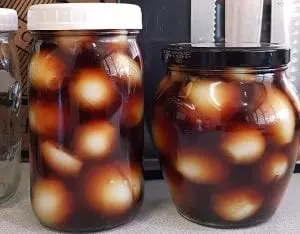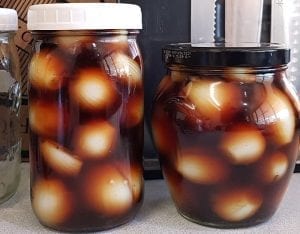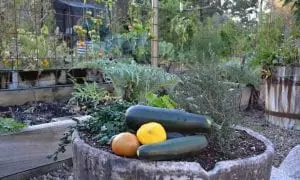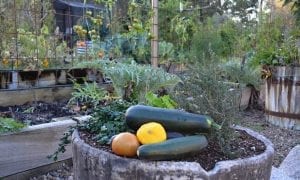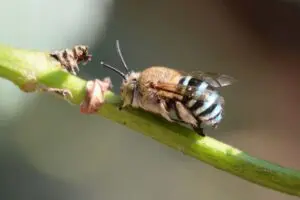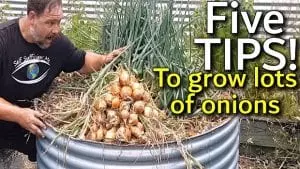This article was updated on 28 Nov 2015 I‘ve known people who have given up and given away their chickens simply because they felt chickens were too much trouble to look after. In fact, we’ve even benefited from people asking us if we could take their birds off their hands for free because they were that desperate to get rid of them.
However, keeping chickens and other poultry can be made harder than it needs to be; especially, if no purposeful consideration as to how the birds are fed is done. On the other hand, and with the right forethought and feeders, keeping chickens can be deceptively easy even for large flocks consisting of different breeds or other species of poultry.
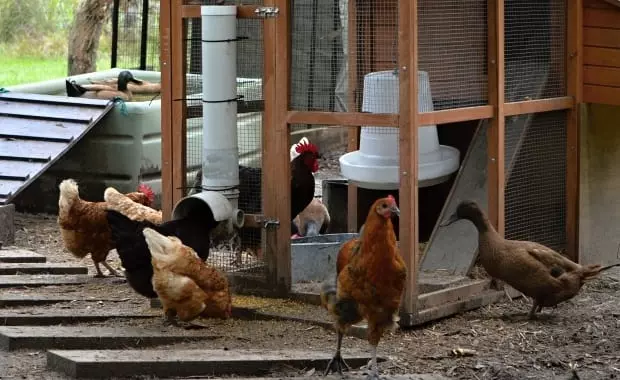
A PVC tube feeder, galvanised "D" shape feed container, and a large hanging feed dispenser (image above) – all help to keep my poultry happily fed
Over the years I’ve tested and used many types of chicken feeders and it’s only when you start keeping chickens (and also other poultry) that you realise not all feeders are equal and there’s more to a chicken feeder than just a container holding grain which is plunked down in the middle of a chicken pen.
The trick is getting your chickens fed without: constantly cleaning poop out of the feed; picking up overturned feed containers; keeping water out; keeping dirt from getting scratched in; keeping other animals out (like rats); stopping feed from going everywhere; and keeping the container from running out of feed every 5 minutes, and it’s all about the type of container, where it’s placed, and how it’s used.
There are lots of different poultry feeders available on the market. Some feeders are very basic, which doesn’t necessarily mean they are bad, and some feeders are extremely innovative but that doesn’t necessarily mean they are free from faults.
Considerations when choosing a chicken or poultry feeder
An important fact to note about a chicken’s eating habit is how small their intestinal track is, which means, food is passed through their body rather quickly. Therefore, chickens are constantly hungry and thus graze for most of the day. If a chicken runs out of feed, they will soon start to compensate by reducing egg production or even eating eggs! Obviously, egg production is very important for most chicken owners so reducing egg production inadvertently through poor feeding should be avoided.
Chickens are crazy for food and are always looking to eat! Three X-bred pullets with PVC feeder in background (image below)
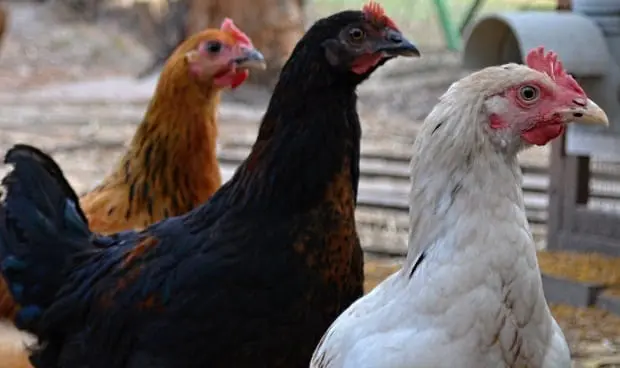
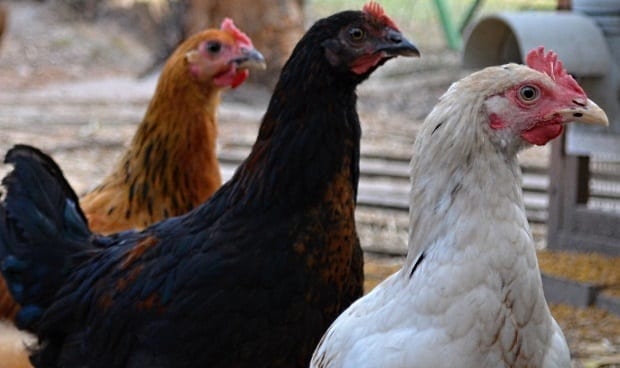
What chicken feeder to use depends on several variables:
The number of chickens and other birds – Chickens are a flock bird and they like co
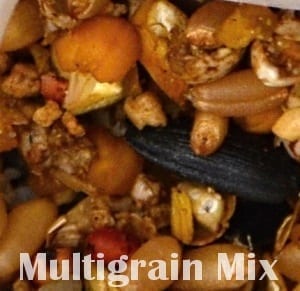
If you have more than 4 large chickens then you’re starting to get into the larger containers or automatic feed dispensers to ensure the feed is adequate and doesn’t run out prematurely. Also, if you keep other species of poultry (like ducks) mixed with your chickens you may need different feeders or stations to accommodate their needs.
Where you are located – If you live in a pretty sterile urban environment or a place with little competition from other animals you may find the kind of feeder doesn’t matter too much with respect to other critters getting into and eating your chicken’s feed. However, in some urban and co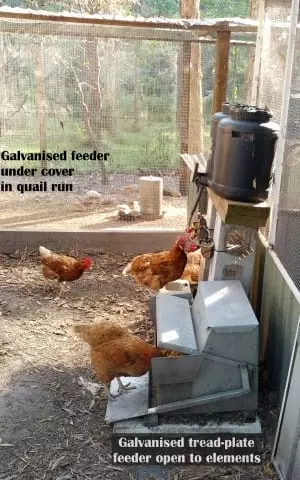
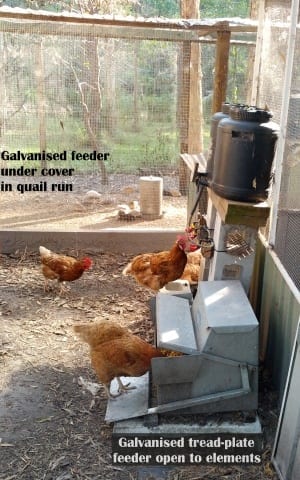
Weather and climate also plays a part when choosing a chicken feeder: does it need to be waterproof or will the feeder be kept under cover, for example?
The type of enclosure your chickens are housed – Similar to your location, the type of enclosure your birds are kept in can influence the type of feeder required. Also, if the enclosure is segmented or divided it may mean one or several feeders are necessary – same if you have different groups of birds within the flock, more than one roosting area, or if there are other birds mixing with your chickens like ducks, for instance.
The type of feed you typically use – Not all poultry feed is the same. Some poultry keepers like to feed their flock a dry grain or pelletised feed and others like to feed with a finer mash or even a wet/moist mash. The type of vessel used to deliver these feeds needs to be considered to ensure blockages are prevented and the feed is easily accessed by all birds.
Your commitment and time – Can you afford the time to check and administer feed on a daily basis? For some people, the act of filling up the feeders daily is a welcome chore and a way to keep in touch with the birds. Others prefer to just collect the eggs and only be required to refill the feeders every few days, week, or even longer.
If you don’t mind refilling the feeders daily then having a feeder/s which holds an adequate enough feed for 24 hours is suffice. The advantages of refilling the feeders daily are: the ability to monitor the feed closely, option to vary the feed daily, feed won’t go stale, more time observing the birds, and less wastage from chickens scratching feed out.

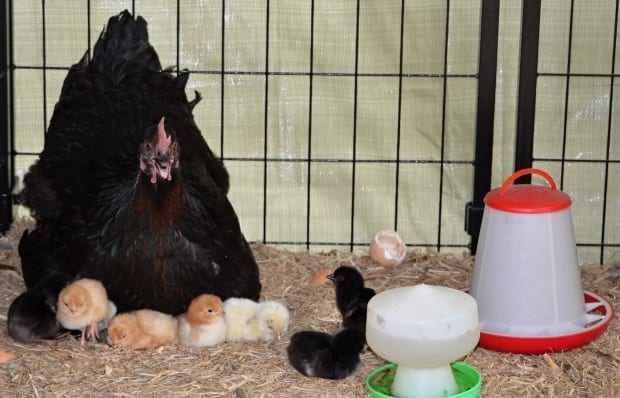
Small feeders are good for chicks the red feeder (right) holds about 1kg of feed and can be used for one or two adult hens no problems (image above)
For those who would rather not refill feeders every day, getting a feeder/s which holds enough feed for your flock to get their daily requirement over several days or more is a great option. Nevertheless, it should be said going overboard and using a feed container so large compared to your flock that the feed takes several weeks to run out is not recommended as the feed will likely spoil or become cloggy through moisture absorption (especially in humid climates). Personally, I ensure the feed in my feeders is eaten within 10 days maximum (usually 7 days).
Besides the time saving, other advantages of having a feeder which allows longer times between refills are: less chance of the birds going hungry, less physical effort required to maintain the pen, and able to go away for a weekend break without worrying about feeding the chickens.
Spillage – Unfortunately, some feed spilling onto the ground beside the feeder is unavoidable and I challenge someone to show me a feeder that’s spill proof. However, a feeder with high sides will lessen feed spill onto the ground considerably and some feeders come with a mesh or restrictive barrier, which is positioned on top of the feed to help prevent the chickens from scraping the feed out.
I personally have found feeders with a mesh designed to move down as the feed reduces more hindrance than help as it tends to get stuck impeding the bird’s access to the feed. A non-movable mesh barrier on a shallow feeder or a feeder with many segments are better.
Still, some spillage will occur anyway and if the feeder is left to run dry the mess is usually cleaned up by the chickens themselves as they forage. If you are lucky, you’ll have one or two birds that like to pick the spill off the ground rather than eat from the feeder and clean the mess the other birds make.
The image below shows a duck cleaning up the mess made by hens under a PVC tube chicken feeder

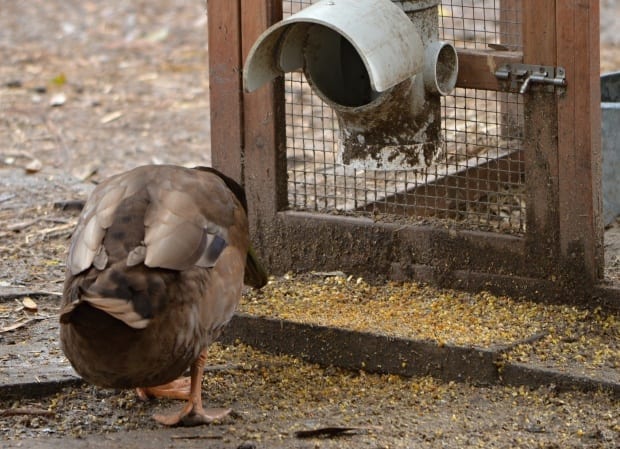
Your budget – At the end of the day, your budget can also influence the type of feeder. Some feeders are very expensive and practically out of reach for some people; therefore, a balance needs to be struck to ensure money is spent wisely and costs can be saved where possible.
Something I have noticed in my part of the world is a surge in large corporate pet food and accessories suppliers BE WARY because big doesn’t necessarily mean cheaper or better! Often these big shops are large stockists of goods with little customer service and sell feed repackaged into smaller bags at huge mark-ups to hock-off to the “city buyer” with limited experience. The prices for feeders are no better and recently I’ve seen prices close to double what my local small retailer sells them for so it pays to check the small local before committing.
Types of feeders
Trough – A trough feeder can come in many sizes and be fixed to the side of a coop w
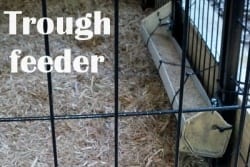
Unless the trough feeder is a large stand alone unit with its own roof, it should be positioned out of the elements, and if it is too small it will get knocked over so it should be fixed to something. Being an open feeder it can be used for all types of feed. You can get trough feeders here on eBay.
Open container bin – Open container bins are similar to a trough but obviously not as long and therefore can become crowded with several birds trying to eat at the same time. Utilising more than one container placed in different areas can help negate overcrowding. Open feed bins are easy to refill and are great to use as a supplementary feeder along with other feeders or as a special treat container for scraps, and wet feed for worming medication etc.

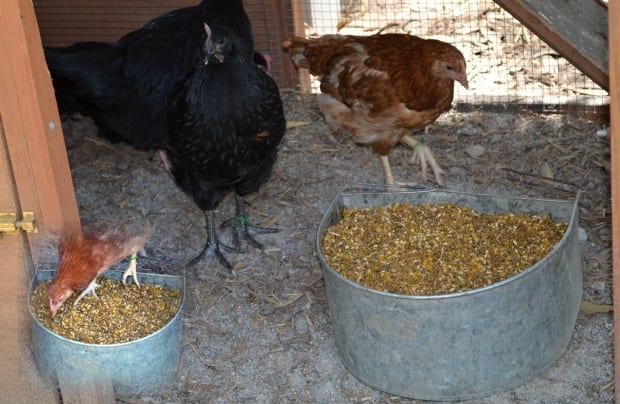
Open "D" shaped galvanised feeder bin (image above)
Open feed bins are susceptible to chickens jumping in and scratching so if this is a problem try a “U” shaped open container and fix it to a wall or place a mesh over the top so their heads can just pop through, this will stop hens jumping in and scratching around.
Basic feed dispenser – The common commercial feed dispensers come in all sizes from very small to about 20 kgs (40 lbs) and are usually made of UV resistant plastic. They can be a cost effective feeder; although, some prices are ridiculous depending on where the product is purchased so shop around. Galvanised dispensers are even more expensive to buy but they do last longer and are a more durable product lasting for decades (potentially).

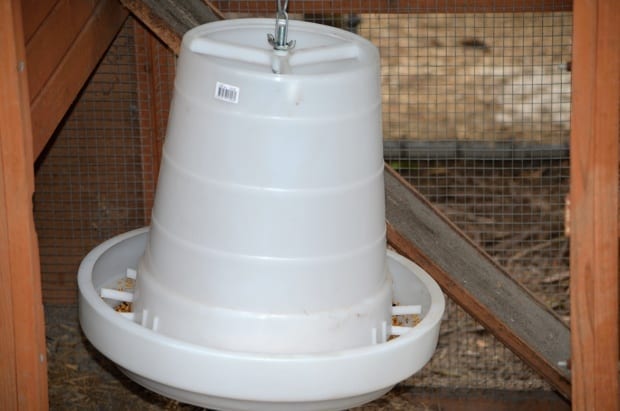
This feeder holds up to 15 kgs (30 lbs) of chicken feed. With its high sides, lip, and segment bars it keeps feed loss to a minimum. The side deepness can also be adjusted to suit from the top screw (image above).
Dispenser feeders work well by releasing feed as it is eaten from the enclosed container. The f
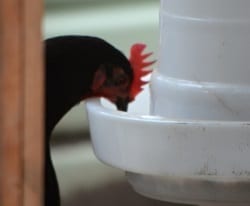
These feeders tend to do best dispensing dry feed but are capable of being used with a moist mash.
Some feeders are designed with a little roof to help keep the feed dry in rainy weather; however, in heavy rain keeping a basic feed dispenser undercover is the best option. You can find large gear feeders here on eBay.
Tread-plate feeders – Although tread-plate feeders have been around for decades they are still a relatively new commercial product with the popularity of tread-plate feeders starting to take off over the last few years. They generally hold around 10-20 kgs of dry feed and some of the top commercial feeders can be quite expensive to buy.
The image below is a commercial tread-plate feeder called Grandpa's Chook Feeder which was originally made and designed by a guy (probably a grandfather) in New Zealand – can hold up to 18 kgs (40 lbs) of feed

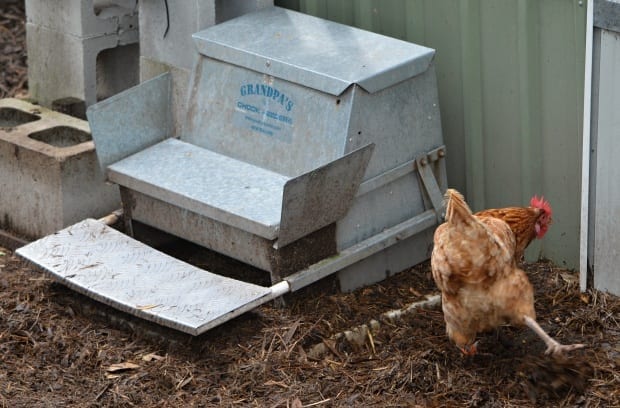
These feeders work by utilising a pressure plate system where the chicken steps onto the plate, which subsequently opens the feeder lid allowing the chicken to eat. When the bird steps off the tread-plate the feeder lid shuts and this in turn protects the feed from wild animals and birds. Rats and mice can become a real nuisance around feeders as they not only eat the grain but they can also contaminate the feed and introduce disease.
Nevertheless, tread-plate feeders alone will not prevent rodents being attracted to the chicken pen because all feeders will have some sort of spillage as the hens pick through the feed but at least rats won’t be able to get inside the feeder.
Rain won’t get inside either so if you need to have a feeder out in the open weather, tread-plate feeders are a great option.
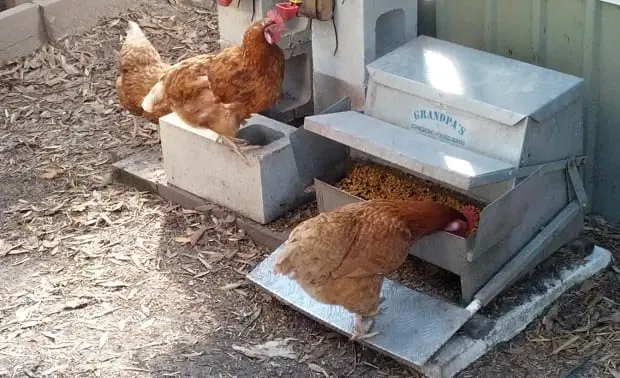
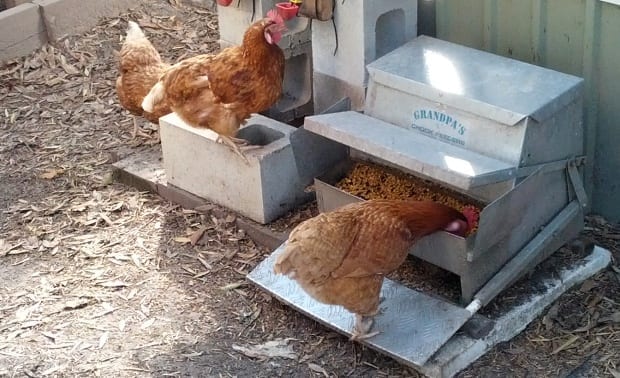
A tread-plate feeder in action (image above) This feeder has been open to the elements for a few years and it's still going strong
Some training is required for the birds to get used to eating from the tread-feeder but this usually takes under 10 days, after which, the hens will be using it like it’s second nature. Training involves a simple technique of incremental lid openings where the feeder lid is started wide open and then gradually closed as the birds get accustomed to stepping on the tread-plate and seeing the lid rise up.
Once a few hens get the knack, the rest learn from them and this is true for any other birds subsequently introduced to the flock. I also keep domestic ducks and they use the feeder sometimes and my chickens have inadvertently trained wild ducks in the past in how to use the feeder also. However, often wild ducks are too light to force the pressure plate down on their own and I’ve seen a few work out a plan of grabbing some feed at the same time a chicken has the lid open – cheeky.
Larger tread-plate feeders are not recommended for chicks, young birds, or very small breeds.
PVC tube feeders – PVC tube feeders are another relatively new feeder to be commercially market
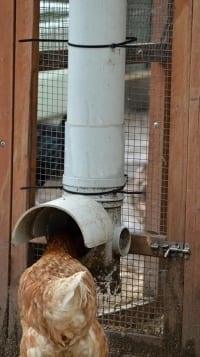
Naturally, only one chicken can use the feeder at any one time; therefore, if no other feeders are to be used; then, I would recommend one feeder per 4 birds.
Also weather proof, tube feeders are a simple design, lightweight, and can be fixed to a wall, fence, post, or even a stake. If the PVC tube feeder is fixed correctly to a post or wall, rodents will not be able to access the feed either because the little buggers can’t climb the slippery tube.
As for all feeders, there often is feed dragged out which gathers underneath but it isn’t too big of a problem and does get cleaned up by the birds particularly once the feeder is empty.
I’ve found PVC tube feeders handy to have as a secondary feeder placed away from the main feed area for those birds that get bullied to grab a quick snack as they go past. My ducks are also particularly fond of using this type of feeder.
Ducks using a PVC tube chicken feeder (image below)

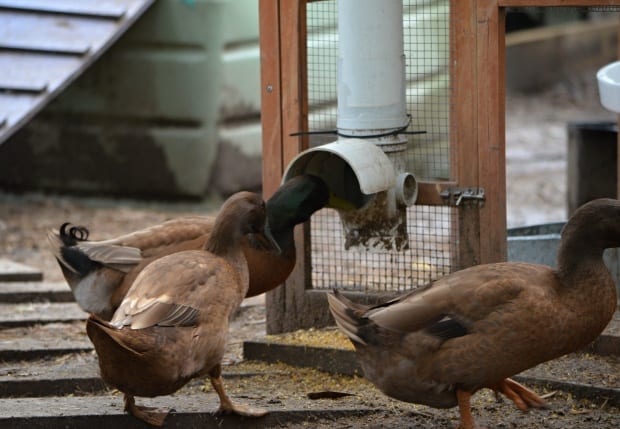
Homemade feeders – There are lots of clever ways to make chicken feeders out of recycled materials. The bucket method made from those large plastic white paint buckets is a simple, cheap, and good one.
Basically, some holes are cut into the base of the bucket and the bucket then placed into a plastic pot plant saucer wide enough for the bucket to fit into with a few inches to spare. When the bucket is filled with feed, gravity helps the feed trickle out the holes into the saucer and as the chickens peck away more feed comes out. Also, the saucer can be glued to the bottom of the bucket (if you want) and then the bucket hung by the wire handle just above chicken bum height and this will keep the feed nice and clean.
I have also made my own DIY feeder design it's incredibly basic but it's cheap and works – you can see the article and video here.
Feeding by hand – When I was a child, I used to visit My Uncle Ernie (who owned a dairy farm) and sometimes stay for up to a week over the holidays. I have memories of him and my cousins feeding the free range chickens once daily with a bucket of feed and scraps. They had no dedicated feeders and most of the hens happily roamed freely fending for themselves on the farm and laying eggs in all sorts of places.
This method did seem to work for my Uncle; although, as stated earlier it’s better if chickens do have a constant supply of feed to fall back on even if they are strictly free range, in my opinion anyway.
White Sussex in background eating from a galvanised feeder with rain lid to protect feed from light rain (image below)

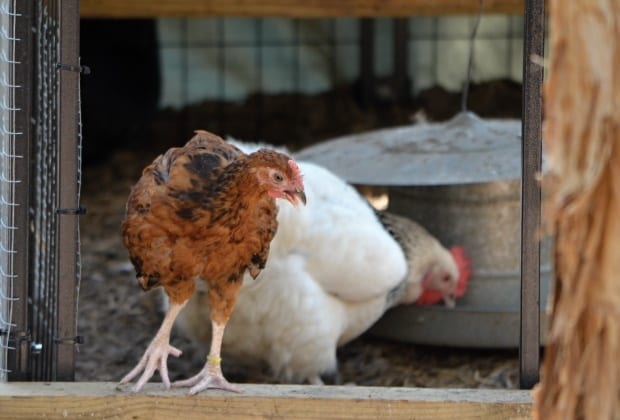
Conclusion
In the end, not all chicken feeders are the same but with some simple consideration you can select the right feeder/s for your situation so that it suits both you and your hens.
No matter where you live, how many chickens or other poultry you have, or how they are housed, the right chicken feeder for any budget is available and the choices are plenty. So, if you’re not happy with that complementary, generic feeder you received when you got your first hens, then ditch it and get a feeder that’ll make everyone happy.
Check out a great variety of feeders here on eBay.
Feel free to make a comment in the comments area below or if you would like to discuss chicken feeders more in depth then visit our forum where I have created a thread specifically for this article.
Thanks for reading and thanks for your support.
Look, and see the Earth through her eyes
Mark Valencia – Editor SSM

